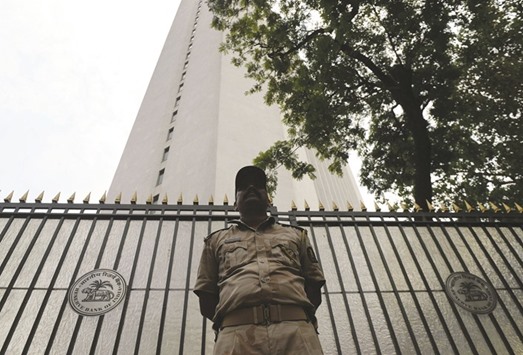Big Daddy? That’s how traders in Mumbai refer to the central bank when it intervenes to curb rupee swings, a strategy used by former Governor Rajan that’s seen volatility dwindle to the lowest level among emerging-market currencies after the Chinese yuan and pegged Hong Kong dollar.
Early signs are that new Governor Urjit Patel is just as committed to the cause, though he’s having to work harder to stabilise the rupee: India’s foreign-exchange reserves slumped by the most since 2013 in the first week of October, suggesting officials sold dollars to bolster the currency.
While Big Daddy might be unpopular with traders who make a living from volatility, he’s been a friend to investors, with the currency calm helping the rupee deliver Asia’s best total returns. That may be setting up the market for a rude shock. Patel has already provided one surprise - an interest-rate cut that Nomura Holdings said diluted the bank’s previous inflation framework - and Mecklai Financial Services says investors and companies are unprepared for the consequences should the central bank lose its rupee grip.
“Pushing volatility continuously lower has its risks,” said Jamal Mecklai, a 40-year veteran of the currency market who has served on two committees set up by the RBI and runs treasury risk-management firm Mecklai Financial Services. If the central bank is signalling a more accommodative policy stance, “is this making hot money hotter. If and when the turn comes, will people fly faster?”
India’s monetary authority has bought and sold $415bn since August 2013, about five times more than transacted in the previous three years. Former Governor Rajan had said the central bank intervenes to curb volatility and doesn’t target any particular rupee level.
Investors are now eagerly watching the central bank’s policies amid rising risks from maturing foreign- currency deposits and as a potential Federal Reserve interest- rate increase hangs over global financial markets.
The central bank calls currency desks inquiring about the kind of inflows they are seeing or why they are buying or selling dollars when rupee moves appear unusual, according to two traders, who asked not to be identified citing rules. As well as Big Daddy, there’s also “Daddy” for the biggest state- run bank that the RBI uses to carry out its orders.
“The RBI’s presence in the currency market is the main reason for the rupee’s stability,” said Rohan Lasrado, Mumbai- based head of foreign-exchange trading at RBL Bank. “On most days, there is hardly any movement in the rupee and on few days of action, it stands on both the selling and the buying side to make sure it’s on top of everyone in the market.”
The intervention has helped curb growth in rupee trading, with average daily turnover rising by $6bn in April 2016 from three years earlier, compared with a $14bn increase in the prior survey period, data from the Bank for International Settlements show. The Reserve Bank of India didn’t immediately respond to an e-mail seeking comment.
The central bank’s involvement in India’s foreign-exchange market underwent a sea change after the rupee fell to a record low of 68.8450 per dollar in August 2013 and Morgan Stanley named the currency as one of the “Fragile Five” due to its vulnerability to capital flight. While the RBI never announced a policy change, its presence in the market has been increasingly hard to ignore.
Traders can reel off a long list of times when they say the rupee’s moves prompted central bank intervention, which is said to be carried out through state-run lenders including State Bank of India, which declined to comment.
In January and February, when the rupee fell 3.3% as concern about China’s sinking yuan fuelled a global market rout, the RBI’s foreign-exchange reserves contracted $5.3bn.
The central bank was said to be in the market after then-Governor Rajan said he’d step down from the top post, days before the UK’s vote to exit the European Union. It was also said to have sold dollars after India attacked terrorist camps in Pakistan last month.
Expected rupee swings over three months fell to an eight-year low of 5.4% on Thursday from 21% in August 2013. The Indian currency’s average daily trading range has been about 0.20 rupee so far this year, the narrowest since 2007 and less than half of what it was in 2013.
Volatility isn’t suppressed only in the rupee. The same tranquillity has crept into currency trading worldwide, with the JPMorgan Chase & Co global currency volatility index falling to the lowest level since December this month.
For investors, the lack of currency swings has meant that borrowing in dollars to purchase rupee assets earned 15% in the past three years, the highest in Asia, data compiled by Bloomberg show. Buying the Indonesian rupiah delivered a 4.6% return.
India’s economic fundamentals have also grown more attractive for investors over this period with a narrowing current-account deficit and slowing inflation. Prime Minister Narendra Modi has accelerated the reform process and vowed to lower the budget deficit.
That’s assisted the RBI with another cornerstone of its currency policy - boosting foreign-exchange reserves, which reached a record $372bn in September.
For Patel, the war chest may have already stood him in good stead as he manages an outflow of $20bn that began in September and will continue into year-end with the maturing of deposits held by non-resident Indians. The RBI’s reserves fell $5.9bn in the first two weeks of October, suggesting dollar sales to shield the rupee.
Currency markets will soon face further uncertainty as the US presidential elections approach and amid rising odds of a Fed rate increase by December that has already put emerging- market currencies under pressure.



